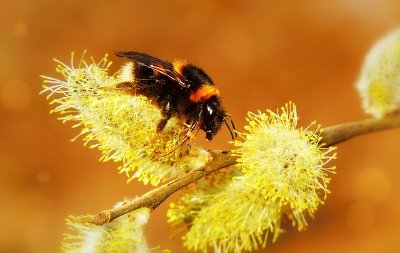Various types of pollination occur in seed plants.
As to plant-to-plant pollen transfer, two types exist self-pollination and cross-pollination.
Classification has also been made according to agents of pollination.
Having a sufficient understanding of these pollination mechanisms is important in crop agriculture.
Knowing the normal mode of pollination of any crop can accelerate crop improvement works because plant breeding methods are pollination type-dependent.
Proper cultural management practices, such as in relation to pests and diseases control and biodiversity, can be identified to favor populations of animal pollinators.
The process of pollination precedes fruit and seed formation in the angiosperms and seed formation in the gymnosperms.
Both fruits and seeds perform functions in plant reproduction. In particular, the seeds serve as the major, immediate, direct progenitors of new plants.
In addition, many agricultural crops are grown for the primary purpose of producing either fruits or seeds or both.
What is Pollination?

Pollination is the transfer of pollen grains (male gametophyte) from an anther to a stigma in the angiosperms.
In the gymnosperms, it is the transfer of pollen grains from a microsporophyll (in the male cone in the conifers) to the micropyle of an ovule (in the female cone in the conifers).
Self-pollination in the angiosperms is a type of pollination which occurs in a single plant either in two ways: within the same flower (also called intrafloral pollination) or between two flowers (interfloral).
In contrast, cross-pollination is the transfer of pollen from the anther in a flower in one plant to the stigma in a separate flower in another plant.
Cross-pollination, therefore, necessarily involves two flowers and two plants.
Consequently, self-pollination results in inbreeding or selfing in which gametes carrying identical gene constitutions are united.
In contrast, cross-pollination leads to the union of unidentical gametes in the breeding system called outbreeding, also called outcrossing, allogamy, or xenogamy (Simpson 2010).
Types of Pollination: Abiotic vs. Biotic
Various types of pollination have also been identified based on the vectors of pollen grains or agents of pollination.
These pollinators are described under two main classifications:
(1) abiotic, i.e, nonliving pollinators, and (2) biotic, i.e., living pollinators.
The abiotic pollinators are the wind and water, the latter with a limited occurrence in a few aquatic plants.
Biotic pollinators refer to various animal species with insects as the most dominant.
However, plant species may be either specialists or generalists (bio.fsu.edu 2013).
Specialists are those having floral features which attract a single type of pollinator while generalists are those who attract many pollinators.
In the gymnosperms (Cycadophyta, Ginkgophyta, Pinophyta, and Gnetophyta), pollination is mainly carried out by the wind.
But in the angiosperms, the most dominant agent of pollination is animals, particularly insects of which the bees are common in many plant species.
A list of various types of pollination and the respective pollen vectors involved are provided below.
The technical terms were obtained from Simpson (2010).
Some representative plants are cited from Moore et al. (2003), Simpson (2010), and bio.fsu.edu (2013).
Types of Pollination According to Agent of Pollination
1. Anemophily – pollination by wind, e.g. in many grass plants (Poaceae or Gramineae) and sedges (Cyperaceae).
2. Cantharophily – pollination by the beetle.
3. Cheiropterophily – pollination by the bat, examples the century plants (Agave spp.), white saguaro cactus (Carnegiea), some bananas (Musa spp.).
4. Entomophily – a composite term for pollination by insects.
5. Hydrophily – pollination by water, e.g. the aquatic plant’s seagrasses (Zostera sp.) and ribbon weed (Vallisneria spiralis).
6. Melittophily or hymenopterophily – pollination by bee, example the aster by bumblebee.
7. Myrmecophily – pollination by ant, for example in the Dwarf owl-clover (Orthocarpus pusillus).
8. Necrocoleopterophily – pollination by carrion beetle, for example in the carion flower Hydnora africana.
9. Ornithophily – pollination by bird, for examples the Mimulus cardinalis by hummingbird and the bell-fruited mallee (Eucalyptus pressiana) by jellow-plumed honeyeater.
10. Phalaenophily – pollination by moth, examples in the evening primrose (Oenothera biennis), some tobacco (Nicotiana spp.), most honeysuckle (Lonicera spp.), Verbena, and Lantana.
11. Psychophily – pollination by butterfly, for example, the Indian paintbrush (Castilleja sp.) by swallowtail butterfly.
12. Sapromyiophily – pollination by flies such as the carrion, dung, and mushroom fly, for example in carrion flowers which emit foul odors.
In addition, the Australian honey-possum, a tiny mammal, feeds on pollen and nectar and in the process pollinates the coral gum (Eucalyptus sp.) (Moore et al. (2003). Fig (Ficus) is pollinated by gall wasps (bio.fsu.edu, 2013).
REFERENCES
BIO.FSU.EDU. 2013. Chapter 4: Pollen vectors and pollination syndromes. Retrieved Nov. 24, 2013 from http://bio.fsu.edu/~winn/3402L/WinnCH4.html.
MOORE R, CLARK WD, VODOPICH DS. 2003. Botany. 2nd ed. New York, NY: McGraw-Hill Companies, Inc. p. 398-401.
SIMPSON MG. 2010. Plant Systematics. 2nd ed. Burlington, MA: Elsevier Inc. p. 573-584.
